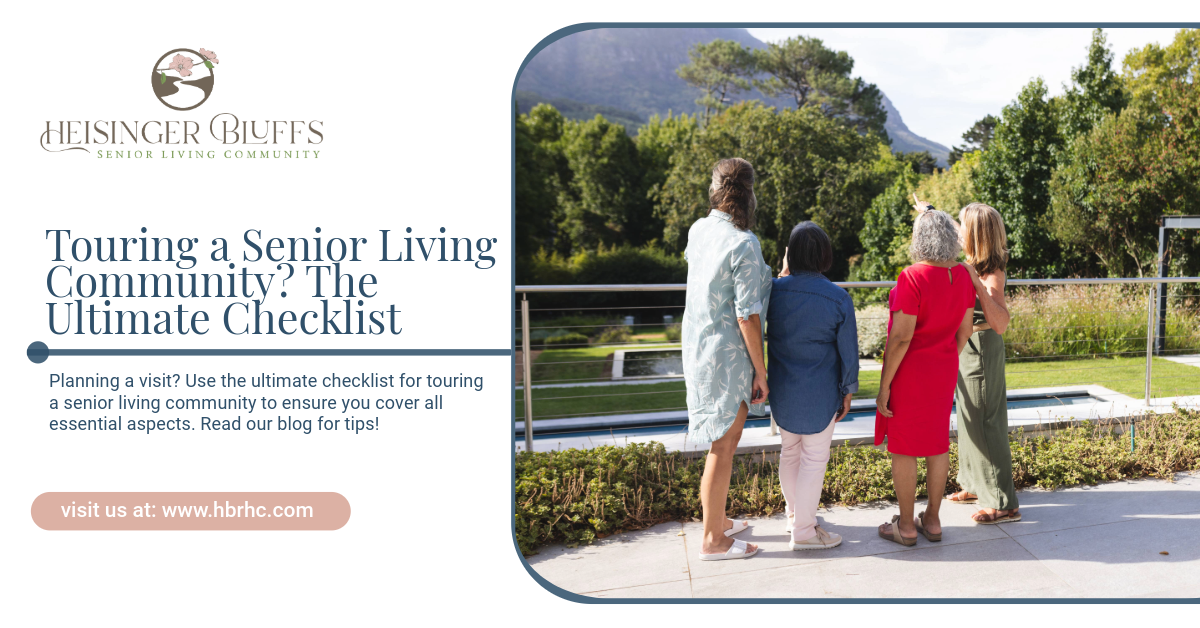Touring a Senior Living Community? The Ultimate Checklist

Key Highlights
- Touring a senior living community requires a clear checklist addressing care, amenities, accessibility, and more for an informed decision.
- Different senior living options like independent living, assisted living, and memory care cater to varying levels of care and medical demands.
- Evaluation includes personal and medical needs, budget considerations, and touring common areas to ensure the quality of life.
- Observing staff interactions and resident engagement provides insight into the overall atmosphere and care quality.
- A thorough review of amenities, dining options, and activities helps confirm if a community provides a perfect fit for healthy living.
Choosing a senior living community is a big step for older adults and their families. It is not only about picking a place to live. You want to make sure the place helps everyone have a good quality of life. Right now, there are many places to choose from. So, how do you know if you are making an informed decision? You need to use a helpful checklist. This guide gives you all the things to look at when picking the right community. You can see the level of care, the amenities, and more. With this help, you can pick a place that gives you a better, more supportive life.
Understanding Senior Living Communities in the U.S.
Senior living communities in the United States offer many choices. These places give older adults different housing options. They aim to meet the needs of people at every stage of life. They look after the physical, emotional, and social needs of each person.
Some places feel like high-end resorts. Some are smaller and feel more like care homes. The choices fit many lifestyles and different levels of medical needs. There is assisted living, independent living, and memory care available. This helps people find what is right for them. It gives everyone a good place to live, grow, and get the care they need.
Types of Senior Living Options
Senior living options cater to diverse needs, ensuring everyone finds the right fit.
Independent living suits active seniors seeking a maintenance-free lifestyle. These communities offer plenty of social opportunities and prioritize involvement.
For those needing daily assistance, assisted living provides a blend of independence and care. Residents maintain their own space while receiving help with tasks like dressing and medication, offering peace of mind for families.
Memory care supports seniors with memory issues, such as Alzheimer’s. These programs provide a secure environment and structured routines alongside engaging activities that promote well-being.
Overall, senior living options ensure there’s a safe and welcoming home for everyone, regardless of their needs.
Who Can Benefit from Senior Living?
Senior living can be a good choice for many older adults, depending on what they need and how they live. If you are an active senior, independent living communities let you live without the hassle of daily chores. These places help you make new friends and join social events.
Older adults who need some help with things like cooking or taking medicine may do well in assisted living. In these places, you get support when you need it, but still have your own space. Assisted living gives you safety and help every day, as well as chances to do things you enjoy.
If you are caring for someone who has dementia or other memory problems, memory care communities can help. These places give you peace of mind. They offer special care and set routines that fit what your loved one needs. Senior living can help improve a person’s quality of life, no matter if you want more social time, better mental health, or support with daily tasks. Each community can meet different needs for you or your family.
Key Factors to Consider Before Your Tour
Planning an on-site tour is key when you want to pick the right senior living community. Start with a checklist that looks at important things like accessibility, the many amenities, and the overall feel of the place.
Take your time to look at what the community has to offer before you go. Ask them about the housing features, dining options, social events, and what security measures they have. Always keep in mind what your loved one wants and needs, so you can find a community that helps them have a better quality of life and gives peace of mind to the whole family.
Assessing Personal and Medical Needs
Choosing a senior living community requires understanding medical needs. Assess the individual's current health: do they need daily medical care or occasional assistance? Ensure the facility meets these requirements and has emergency medical services available.
Dietary needs are also crucial for well-being. Look for communities offering menus that cater to specific health conditions like diabetes or heart disease, while allowing residents to choose fresh, balanced meals daily.
Finally, consider how the community adapts to changing care needs as residents age. The best facilities provide support for issues like memory loss or mobility challenges, ensuring residents feel safe and at home.
Budgeting and Financial Planning
Finances are crucial when selecting a senior living facility. Start by assessing your budget and exploring affordable housing options while considering long-term costs.
Senior living communities have varied pricing structures. The base price typically covers rent, but additional charges may apply for medical care or services. Ensure you understand all costs upfront, including what the monthly fee includes, such as utilities, meals, and amenities.
Consider seeking financial planning assistance, such as long-term health insurance or Medicaid. By planning early and evaluating all expenses, you can make an informed choice that benefits both you and your family.
Beginner’s Guide: How to Prepare for Your First Senior Living Community Tour
Your first time visiting a senior living community is a chance to see if it is the right fit for your loved one. To start, make a checklist before you go. Add questions to the list about common areas, the help with health needs, what fun things get done there, and what food choices they have.
Take a planner with you to the visit. Write notes while you look around. Notice the feel of the place, how clean it is, and if the staff seem happy. When you get ready by making a checklist, you make sure your choice matches the quality of life your loved one wants, and you look out for their needs in the long run.
What You’ll Need Before Your Visit
Preparation is key when you visit a senior living community. You should bring a checklist to help you keep track of what you see and remember what to ask. Use this list:
- Bring a list with all the amenities and your medical care needs.
- Write down questions about the staff, food choices, and how safe the place is.
- Take any papers you have about money, so you can ask about the costs and how to pay.
- Look at the cleanliness. See if the people living there seem happy. Notice the activities they do each day.
Having these things will help you look at everything that matters, making it easier for you to make the right, informed decision about senior living.
Step-by-Step Process for Touring a Senior Living Community
Visiting a senior living community works best when you have a plan.
- Start with a checklist made for your loved one. Look at things like amenities, how safe it is, and how fast the staff help you.
- Ask about what life is like each day. Talk about activities, food options, and health rules.
- See the common areas, look at any outside space, and walk through the living parts. Think about how it feels to be there.
Be sure to ask lots of questions. Talk to people who live there and with the staff, so you can learn about the quality of life for everyone. This way, you get all the important details about senior living that can help you make a good choice.
Step 1: Research and Shortlist Communities
A good senior living move starts with careful research. Check online reviews. Visit places in person. Ask local people for their thoughts. This is how you make your own list of places to choose from. Put more focus on communities that offer different senior living options, like assisted living or memory care.
When you are picking the right place, think about how close it is to family, friends, and medical facilities. Try to find a good balance between how easy it is to get there and the level of care. This way, you help your loved one stay comfy and help them find a perfect fit for their daily life.
In the end, talk with the people to see what it’s like there. Ask for brochures and read what people have said about them before you plan to visit.
Step 2: Schedule Your Tours and Create a Checklist
Setting up tours allows you to explore senior living options. Use this simple table to schedule your visits effectively:
| Tour Scheduling Tips | Key Checklist Items |
|---|---|
| Visit on weekdays and weekends | Assess facility cleanliness and operations |
| Schedule multiple visits if needed | Ensure staff communicate clearly and openly |
| Inquire about unannounced visits | Evaluate food services, meal preparation, and social activities |
This checklist ensures a thorough evaluation of each location.
Step 3: Observe Cleanliness, Safety, and Accessibility
Hygiene and safety have a big effect on the quality of life. When you look at common areas, make sure the resident rooms and bathrooms are clean. Check if these places are neat and if there is no clutter. See if routine housekeeping can be seen.
For safety, see if there are handrails, emergency systems, and safe entrances. Look at accessibility features like elevators and ramps to make sure everyone can move around safely.
Good standards in these areas show the community cares about well-being.
Step 4: Evaluate Staff Interactions and Resident Engagement
Caregiver attitude is an important sign of a good assisted living community. When you visit, look at how the staff treat the people who live there. Are they kind, warm, and patient? You should see friendly talks and staff who really pay attention to the needs of residents. This is what good resident engagement looks like in an assisted living facility.
Ask about team skills and training, too. The best assisted living communities put a lot into teaching their staff. This helps make sure people get the medical care and care they need every day.
Watch if residents seem active during the day and if they join in different things. When there is positive talk and support, people feel happier. This helps give peace of mind to both residents and their families.
Step 5: Review Amenities, Dining, and Activities
The best senior living community is the one that has things to make life better. Look at what amenities are there. Is there a gym, art room, or nice places outside to walk or sit?
Food is a big part of this, too. Check if the menu has different options for people with many kinds of dietary needs. See if you can eat there yourself. That way, you get a real feel for what it's like.
Take a look at the activities, too. This could be fitness classes or trips to local events. These things help people in the senior living community enjoy a good quality of life.
Final Thoughts
Choosing the right senior living community is a meaningful decision that can greatly impact comfort, well-being, and peace of mind, for you or a loved one. With the help of this checklist, you can make a more confident choice by focusing on your needs, budget, and the overall environment. Pay close attention to how staff interact with residents, the cleanliness of the space, and the services and amenities offered, as these details shape everyday life.
If you're exploring options, start with Heisinger Bluffs. With a strong focus on compassionate care and vibrant community living, Heisinger Bluffs is here to support your next chapter. Contact us today to schedule a tour!
Frequently Asked Questions
How do I compare different senior living communities?
Use a checklist when evaluating each senior living community. Focus on amenities, layout, and the overall atmosphere for residents. Compare key factors like quality of life, dining options, safety measures, and social activities. This approach will help you find the best fit for your loved one's needs and preferences in their new senior living home.
What should I look for in staff and resident interactions?
Observe if the staff are attentive, approachable, and respectful. Good resident engagement indicates effective care in assisted living. A strong team demonstrates kindness and professionalism, ensuring residents feel supported and secure through prioritized accessibility.
How do I know if a community is the right fit for my loved one?
Check if it meets what your loved one needs. A perfect fit has caring staff, the right medical care, and good amenities. Looking at it all as a whole will help you feel sure about your senior living choice.
Sources:
- https://www.alz.org/alzheimers-dementia/what-is-dementia
- https://www.who.int/news-room/fact-sheets/detail/ageing-and-health
- https://medlineplus.gov/nutritionforolderadults.html
- https://www.medicaid.gov/











